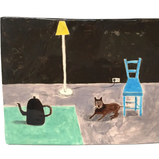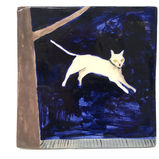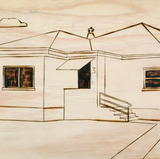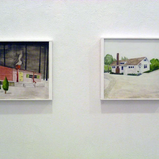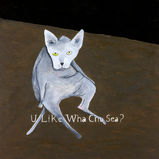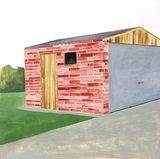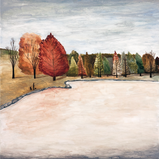b. 1956, Brisbane, Australia
Lives and works in Sydney, Australia
McKenna has exhibited regularly since the early 1980s and recent solo exhibitions include- Art of Collecting- Noel McKenna, Bank of America Merrill Lynch, Sydney (2016), Art Basel Hong Kong 2014 with Mother's Tankstation, Noel McKenna, Absurdia: Noel McKenna- A Focus, Newcastle Art Gallery, NSW (2012), Michael Reid at Murrurundi, NSW (2010), Noel McKenna - 29 centimetres closer, Brett McDowell Gallery, Dunedin, New Zealand (2010), Northland, mother’s tankstation, Dublin, Ireland (2008,2011,2015), and The Weekly Bus-Rail Ticket: Noel McKenna, National Art School Gallery, Sydney (2008). McKenna’s work is frequently included in group exhibitions including, The Popular Pet Show, National Portait Gallery, Canberra, (2017), Solitaire, Tarrawarra Art Museum, Victoria (2014), Conflict: Contemporary Responses to War, UQ Art Museum(2015), South of No North, Museum of Contemporary Art, Sydney (2013), Basil Sellers Art Prize 2010, Ian Potter Museum of Art, University of Melbourne, Fully Booked, Arts Project Australia, Melbourne (2010), avoiding myth & message: Australian artists and the literary world, Museum of Contemporary Art, Sydney (2009) and Look out Wembley Arena, MOP, Sydney (2008).
His work is held in many significant public and private collections throughout Australia and New Zealand including Museum of Contemporary Art, Art Bank, Australia, Art Gallery of New South Wales, Australia, Art Gallery of South Australia, Australia, Macquarie Bank, Sydney, Australia, National Gallery of Australia, Canberra, Australia, National Gallery of Victoria, Australia, Parliament House, Canberra, Australia, Queensland Art Gallery, Brisbane, Australia, Tasmanian Museum and Art Gallery, Hobart, Australia, and Chartwell Collection, Auckland Art Gallery, New Zealand.
“It is precisely through insisting that every scenario convey constriction and every impulse towards motion is circumscribed—the cat-up-a-tree syndrome, we could call it—that McKenna brings his allegory of escape alive. In choosing vulnerability as the point of composition—jumping, balancing, falling, staring, disappearing—McKenna invests the ‘not-muchness’ of each painting with the quality of an involving struggle. It’s as if McKenna looks at the world and is immediately, effortlessly existential. The effort comes in combating dread with care and feeling...“
excerpt from Noel McKenna by Damien Wilkins, 2005
NOEL MCKENNA

THE INTERIORS
2016
DOORS OF PERCEPTION BY PETER HILL -
I always know when I’m in the company of a great artist when I leave an exhibition of their work and the whole world around me seems to be overlaid with the essence of their vision. It happened in 1986, after a Bill Woodrow show at the Fruitmarket Gallery in Edinburgh. When I left the white cube space and wandered the streets back to Leith, everyday objects took on the “look” of his considered juxtapositions of found objects. It happens when cruising through Los Angeles, and witnessing the fingerprint of Ed Ruscha all over that mega-city’s shop-fronts - stretching up to the Hollywood sign. Rosalie Gascoigne, John Wolseley, Sean Scully, Cindy Sherman, Pat Brassington – each in their very own way hits the spot and makes the mental connection for me.
Then there is Noel McKenna. Since first seeing his work decades ago I have been thrilled with every subsequent encounter. Are they naïve? Are they cartoonish? No, they are some of the most sophisticated paintings and constructions it could ever be your pleasure to encounter. They have the simplicity of form of Giotto and the recognizable characterisations that nod in the direction of Pieter Bruegal the Elder, or Frida Kahlo. But it’s only a nod, because they – those three -are utterly different from each other. These drawings and paintings also have a dark, noir-ish, psychological edge to them. They veer between the surprising and the everyday. But when they enter that (often domestic) territory, the one we think we all know, they become totally transformative. And we become yet another stranger in a strange land. For this is the world of Noel McKenna himself. His imagination seduces us, and like a reverse-pickpocket, when we get home we find something special secreted in our pocket or purse.
I’d been thinking intently about Noel’s work recently, travelling the Iron Rooster from Geelong to Melbourne, most days, to meet up with Paul Greenaway who was in town for the SPRING 1883 art fair in the Windsor Hotel, where the Australian constitution was signed. And that was where I first saw these wonderful doors. Each day, through the train window, the passing landscape filled with McKenna characters – many of them inanimate objects that under his spell came alive. There were the fly-swat lights of the Cats stadium, where I joined the train at South Geelong station. A cat, weaving through the railings on the platform, gave me a very McKenna-like stare.
There was an abandoned racetrack, seemingly constructed of thin pencil line and watercolour. There were sheds of all descriptions, weather-beaten and paint-peeled – some joined to others, at strange angles, like badly constructed Renaissance chapels and churches.
Then there was the signage, in desolate fields between the big city and the You Yangs. The fairly straightforward “Poo $4 a Bag”; the more puzzling “BOMBARDIER”; the universal graffiti beginning around Footscray but taking on a very particular McKenna spray.
And at the point of entry into Melbourne, the big wheel rising from the desolation of Docklands, with a tiny helicopter hovering overhead like a sinister mozzie.
A quick tram ride up Bourke Street and the head porter gave me a McKenna wink as I entered the faded grandeur of The Windsor. The grand piano on the first floor looked like a painted backdrop to a McKenna theatrical production. And then, I walked through a very special door, at the far end of an Alice in Wonderland-like corridor, and was in Suite 130 GAGPROJECTS’.
I was here to see an example of McKenna’s latest, and I think finest, series of works. Each one is a real door, although sometimes the handles and fittings are at different levels to those you might expect. Set into panels of varying sizes and numbers, are his cast of thousands: the blue cat; the man reading in his armchair under a triangle of light; the woman in bed staring at the ceiling; a computer screen in a strangely-angled room that is as subtle and luminous as a Morandi still life; a clock that might read ten to seven, or is it sixteen minutes to ten?
These museum-quality works – large and chunky, yet at the same time small and intimate, a combination very rarely seen, mark not so much a new departure for McKenna, but an ambitious laying out of his wares within a brilliantly chosen framing device – The Door.
As the artist wrote recently, “Take the domestic interior, which is what this series of doors is about. When we need privacy we close the door and whoever is outside is left to ponder what is going on behind. This set of works is about me thinking about what people do once they are behind the door. For the most part, they are scenes of the everyday, which is what goes on behind the majority of doors. The strangeness of people is sometimes expressed by the rooms they inhabit, by the colour of the wall, the way they place furniture, and other objects around their house or bedsit. The interior is also about the inner, internal part of a person, where one has thoughts about many different things. These range from simple things, like what to wear, to more serious ones that can take in memories both sad and happy, to abstract and even nonsensical thoughts and dreams. Some theorists say babies come out of the womb dreaming. If that is true, then a life lived makes for lots of thoughts and dreams in people’s minds.”
And there you have it. It is as simple and as magically complex as that. Once seen, these images are never forgotten.
Dr Peter Hill
August 2016
ANIMALS AND MEN
2013
ANIMALS AND MEN -
The title, Animals and Men, comes from Kenneth Clark’s 1977 book of the same name. Kenneth Clark was someone we were compelled to study at art school in Brisbane in the mid 1970s. We looked at lots of the films he made about art history but something about his English aristocratic manner really put me off getting anything really out of him. Over 30 years later I still have the book and with his tone of voice out of my mind the book is a great collection of images of animals through the history of art with a very readable text.
I have painted animals for quite a while now so this group of works will come as no surprise to people who know my work but I still love portraying cats, dogs, horses and the like.
I think my love of animals began with the stray cats in the West End, Brisbane where I was born in 1956. I used to save the scraps of food from my family’s plates and when I got my first job delivering newspapers I used to buy tins of cat food for them. All the members of my family dismissed me as being slightly crazy. Throughout my life I have always been surprised when I encounter people who do not share my feelings about animals.
Animals are much more complex than most people give them credit for and the debate I often think about is whether or not they have souls? Having been brought up a strict catholic a soul, to me, is tied up with blind faith which is a requirement of most religions and whatever a soul is, man’s treatment of animals throughout history displays a complete lack of soul. The domestic dog is what I can speak about most having lived with quite a few in my life. They are a perfect example of the attachment object theory that psychiatrists write and talk about. My dogs Max and Rosie and myself have formed an attachment bond as well as with other members of my family. There are many examples of when people die their dogs stand guard over the corpse. I saw a film on dogs once where a dog who had spent his life with a family, was quite old, and one night visited all the people in the house, jumped up on their beds, had a gentle sniff and went downstairs and died. They are very sensitive to peoples’ moods, they have a memory, they dream when they are asleep. Enough said, for me, they are very soulful creatures.
ALL THAT HEAVEN ALLOWS
2011
ALL THAT HEAVEN ALLOWS -
There are many types of homes one could do paintings of, brick homes, wood homes, footballers' homes, dentists' homes, three storey homes, circular homes, the list goes on and on. Most of the homes in this show have a connection to politicians, either a childhood home, birthplace, or where they live today.
The childhood home of Paul John Keating was the first completed in the series. Keating came from humble beginnings as his Bankstown home illustrates and his journey to his current identity as a connoisseur of many things including art, architecture and town planning l am sure has been interesting. It would be hard to adjust to normal life after being Prime Minister with all the power and trappings that go with the job. Living in Sydney it is hard to ignore Mr Keating as he gets a fair amount of exposure in the media especially with his ideas on a major area of public land in the city of Sydney. He has always been an extremely confident person and l think he is perceived by a lot of people as being arrogant and pompous.
The early years of one’s life is very important on how a life turns out so it makes sense that the home one grows up in is important. It is interesting looking at how Paul Keating and George W Bush both grew up in similiar unpretentious homes which in the case of George W Bush did surprise me. I did discover though that as a child, George W Bush was a member of the Roy Rogers Riders Club and he carried in his pocket the club rules which are as follows:
Roy Rogers Riders Club
1. Be neat and clean.
2. Be courteous and polite.
3. Always obey your parents.
4. Protect the weak and always help them.
5. Be brave but never take chances.
6. Study hard and learn all you can.
7. Be kind to animals and care for them.
8. Eat all your food and never waste any.
9. Love God and go to Sunday school regularly.
10. Always respect our flag and our country.
Bob Brown's house in Tasmania seems almost idyllic, unpretentious, friendly, warm and green. Of today's leaders he does come across as the most sincere and of all the homes in this show it is the one l would most want to spend time in.
Hunting Lodge, Finland, is a building designed by Alvar Aalto, the great Finnish architect, in 1945. Aalto is a designer l admire. The hunting lodge was a small scale commission. It has elements of Finnish and German vernacular architecture and is a roughly worked wooden structure with details such as wooden gutters, decorative wrought iron hinges and a turf roof. It is quite a humble almost fairytale like building. Aalto was very well known at the time and had completed much more elaborate and important commissions but was still able to create this unassuming building which is in perfect balance with the cabin's use: to rest in its warmth after a day's hunting.
"The Cosmic Battle for your Heart" Is the name of an ARI in Sydney which ran from 2009 to 2011 organised by the artists Mitch Cairns, Kelly Doley, Brian Fuata and Agatha Goethe – Snape. I went to a few exhibitions there, the building is now gone, but it had a nice sort of patina that old buildings can get, a sort of domestic warmth inside which also helped in the enjoyment of the work shown there.
All That Heavens Allows, is the title of a 1955 Hollywood movie made by Douglas Sirk who was a European intellectual who studied Law, Philosphy and Art History. Leaving Germany on the eve of WWII he arrived in Hollywood in 1942. He started making movies in the 50's which were generally very successful but ignored by the critics and serious film buffs. The movie starred Jane Wyman as a wealthy widow who falls in love with Rock Hudson a much younger gardener.
The main part of the movie is Rock Hudson doing up an old mill on his property which he is going to turn into his home. This building connection may explain why l used the movie's title in this exhibition. I had first seen this movie when I was about 13 but for some reason I had started remembering elements of it recently.
It is a soap opera on one level but the script and some of the photography, the angles, the saturated colour make it quite a stylish film. Sirk himself said of his films " There is a very short distance between high art and trash, and trash that contains the element of craziness is by this very quality nearer to art"
GOOGLE SERIES, MEN SMOKING PIPES, AUTUMN, MEN FISHING, CATS, ETC
2009
GOOGLE SERIES, MEN SMOKING PIPES, AUTUMN, MEN FISHING, CATS, ETC BY NOEL MCKENNA -
Becoming an artist was not, it is not an intention. I don’t think anybody starts with the absolute idea of being an artist....sure you decide to become a museum artist, you can decide that, but in my eyes that’s just as bad as becoming a commercial artist, in the sense that you are not anymore a modern artist. You are subjected to the pope and the prince. The nature of the modern artist is to search, is to be in a precarious position and to be non-professional.
Saul Steinberg, 1986
On reaching 52 last year, I again began to take stock of my reasons for continuing to be an artist. I commenced art school in Brisbane in 1976 so I could say I’ve been in the ‘trade’ for 33 years, and being Catholic remember that was how long Jesus lived for. You have to keep it interesting for yourself. I have never found it too hard to find things to paint, but you do find yourself getting a bit philosophical about whether you can keep it fresh.
I cast my mind back to when I was a first-year architecture student in Brisbane, when one of my lecturers took me aside and said – ‘it’s been my experience with what I have seen of you so far that I don’t hold much hope for you to get through the course, but I think your drawings have the potential to be art.’ I remember first-year architecture to have been a pretty casual affair and about the only difference with my work and a lot of the other students was that it was a bit messier; I could not get the hang of those rapidographs. I started second-year but dropped out after a while and applied to go to art school. At the interview the Dean of the school said – ‘your drawings are a bit weak but we will take you.’
The world changes and the place of art in it changes. Even with the current global recession, money has been one of the big influences on the art world in the last 20 years.
I don’t think money has to be a bad influence; artists need it to have time to do art. Some trends which I think are not positive are: prices achieved at art fairs and auctions are seen as an indication of quality; artists and galleries (mainly young) often exhibit what they think will sell, instead of producing something as if money was not involved. In saying this, I know it is expensive to live nowadays; I am glad I was a student when I was.
The market has its own levelling out process and I am not unduly pessimistic about it. Of course one can argue that just because you’ve been around for a while you shouldn’t be guaranteed a pension, as often being around too long makes your work repetitive, boring and dead.
Now that takes me back to the beginning of these notes and Steinberg’s quote “...nature of the modern artist is to search to be in a precarious position and to be non-professional.”
How do you keep it fresh and interesting for yourself? I think it is different for everybody but you know when it’s not. Some of my more interesting discoveries have been a result of going into a second-hand store and seeing a painting done by an anonymous artist and thinking, I wish I could have done that.
I have always shunned computers but I started to ‘google’ last year. One of the first things I googled was “Men smoking Pipes”. Why? I think I could not recall many images of people smoking pipes in art history except maybe Cezanne’s paintings. I quite like the smell of pipes and it is a rare sight today to see someone smoking one.
Once you google you get taken on many diverging paths and one such path took me to photos of men with hairy chests, moustaches and beards on a site where people sent in comments like “ I wouldn’t kick him out of bed for dropping ash”. These comments are the source of some of the painting titles in this exhibition.
TRAVEL NOTES
2007
ARTIST STATEMENT -
The last painting I did for this exhibition, "3708 Utopia Parkway, Flushing, New York" is a painting of an average looking home in the borough of Queens, New York. When you travel up Utopia Parkway you would not give a second glance at No 3708. For me, the home has a special significance as it was where Joseph Cornell lived from 1929 until his death on December 29th in 1972.
This painting fits in with the concept of images from my travels in the last couple of years, but the fact that Cornell never travelled outside of the USA - hardly ever out of New York - appealed to me as the idea for this show came to me in Nice this year. I had bumped into an acquaintance, who I hadn’t seen for years, and she said "well Noelie, how are you enjoying your first trip overseas?"
I was taken aback a bit, but I hadn’t seen them for years and what can you do about how people perceive you? After that I got to thinking about where I had been in the last 2 years. In no particular order, I have travelled to Wellington, Auckland, Russell, Dargaville in New Zealand, Hong Kong, Osaka, London, New York, Zurich, Nice, The Hague and Sicily. Travel for me includes Australia so I will throw in the Blue Mountains, Brisbane, Adelaide, Melbourne, Canberra, Wollongong and Kioloa.
Most of my travel is linked with exhibitions; I have travelled to every exhibition I have ever had and see no reason why I won’t in the future.
I generally don’t work on the spot when I travel preferring to use photographs when I return home. On my most recent trip in Sicily though, I did quite a few ink and watercolour works on cardboard which I salvaged on my trips to the local supermarket.
A final thought regarding Joseph Cornell, an artist I have long admired, who, for me, is almost an outsider artist, residing in his own world of nympholepsy, but in some ways was an insider exhibiting with Marcel Duchamp, Yves Tanguy, Andre Breton, Alexander Calder, Man Ray and many others at the Julien Levy Gallery New York.
The boxes he made in his basement in Utopia Parkway - often about exotic locations around the world - have done the travelling for him in that almost everywhere I have been on my travels away from my basement, I have encountered one of his works in a museum.
2005
NOEL MCKENNA BY DAMIEN WILKINS, 2005 -
There's a special sort of trouble on tap for most of the inhabitants of Noel McKenna's world. The cat up a tree in Flood Picture is only the most obvious model for the straitened circumstances that grip most of these figures and their settings. Usually it doesn't require anything as spectacular as a flood to promote the sense of deprivation. McKenna loves loss. He finds the trees bare, the fields empty, the sky washed out. Even the water drowning the red-roofed house is not much more than a milky grey cloud.
Such reduction is practised so rigorously that we look at those objects spared sometimes with a curious sort of fondness, always with renewed and quizzical attention. What's the value of what is left? Faced with the elementals--branch, limb, shadow--one is tempted to agree that less is more. And yet that kind of minimalism feels too comforting a vision for this work, where it seems the artist is letting us know that sometimes less is also less.
I used the term 'inhabitants' to speak of the people and animals and things in these paintings; frequently 'inmates' seems a better fit. There's nowhere to hide in these paintings, though escape may be their key concern. Which raises another question: escape from what, into what?
Here we might readily proceed to the single interior painting in the show, where we find someone already gone. Where is the boy in Boy’s Room, Brisbane 1967, that potent study in monastic adolescence? If the bedroom, with its tiny bed and bare walls, its boring wardrobe and crude hanging light, suggests a prison cell, the bike nevertheless has promise. Maybe the boy has used it to cycle off into the wonderful Bicycle with rider on path through forest, an uncanny picture with the ordinary menace of the best children's book illustrations. We work hard not to imagine the path on the point of closing up and swallowing the disappearing figure.
This same boy certainly seems capable of having conjured those riddle images, Small Sphynx and Grey Cat. These are the sort of things he might have looked at. Likewise his loneliness may have found an echo in Grey Horse in Field, where repose and boredom are forever fixed to each other--this too an insight from childhood.
We should note that McKenna's animals, at least from a distance, frequently appear stuffed. However, there's a kind of shock in store. The close-up paintings capture the comic, grave natures of these domestic creatures, their awkward awareness of being looked at, the shy uncertainty of being petted and kept. His cats stare out at us and we wish them gone. There is something compromised for them and compromising for us in this exchange. And while the horse in the field is scarcely a victim, he is as stilled as the boy's bedroom cat which looks as though it’s made of concrete--either that or the cat is another inscrutable intelligence, waiting, just as we wait, for the boy to come home.
What are the options anyhow for these sentient beings? Where can they go? Who can they be? The one animal that is in motion--Horse and Rider Jumping Fence in Field--is only doing so under urging, exercising a 'freedom' that will follow exactly the dimensions of the makeshift riding course.
And finally what should we make of the two cliff paintings? Is that the boy's chair at the top of the cliff, then his dream of falling? Hardly the end we might wish for, though the fall is accomplished while in the sitting position and minus any noticeable distress. There is also the ghost of a bounce in this figure, as if on landing he might come back up. Might he yet somehow escape? (The ambiguity of this bereft 'jolly' image is something like a signature, though McKenna's work feels a million miles from the smirky, didactic ironies of a good deal of contemporary art.)
Of course I'm reading these beguiling paintings as if they belong in a narrative sequence. Moreover the sequence I've described is marked by an adventure, a chase even, certainly a mystery about a boy. Fanciful maybe. And how can such a story be accurate when many of the paintings, experienced individually, seem defiantly undramatic, quiet?
Here I think we're closer to describing not only the way these pictures can work on us and on each other but also something of the tone of McKenna's art. It is precisely through insisting that every scenario convey constriction and every impulse towards motion is circumscribed--the cat-up-a-tree syndrome, we could call it--that McKenna brings his allegory of escape alive. In choosing vulnerability as the point of composition--jumping, balancing, falling, staring, disappearing--McKenna invests the 'not-muchness' of each painting with the quality of an involving struggle. It's as if McKenna looks at the world and is immediately, effortlessly existential. The effort comes in combating dread with care and feeling. The most placid of encounters, meeting a cat one knows, say, gains a rightful strangeness. There is something to be worked out in this moment, the image seems to be saying. That a painting can speak without moving its lips is further evidence of the artist's affecting reticence.
There's one more escape to acknowledge. I have no way of knowing whether the little red bed in Brisbane belonged to the artist as a boy, or whether the cat in the corner, posed like an ornament, had a name, or whether the artist as a boy cycled through the forest or fell from a great height or dreamed of falling--such details belong to Noel McKenna. These paintings are the places he’s hidden these and many other things for us rather beautifully and in plain view.




















